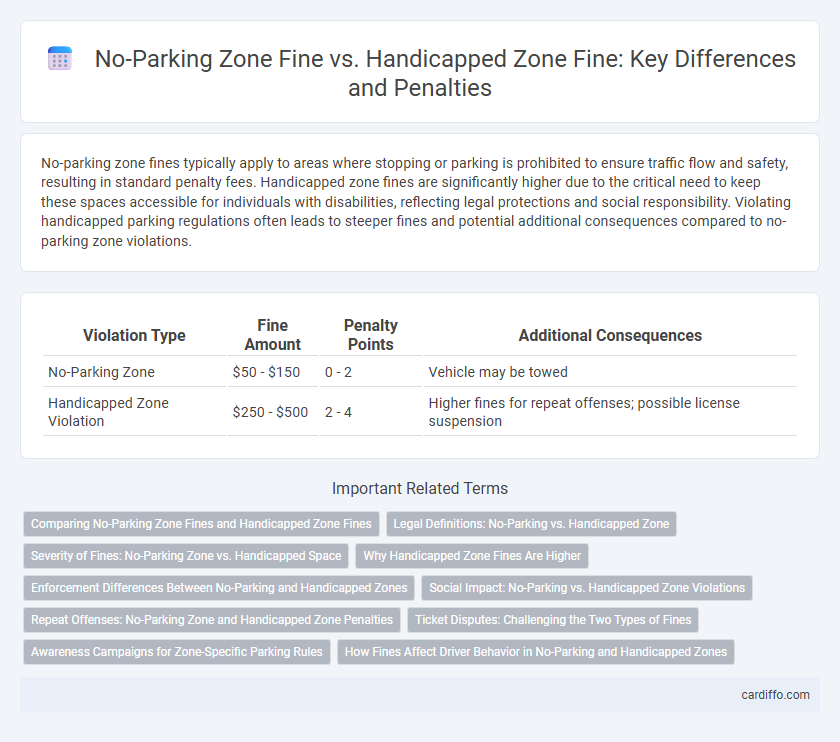No-parking zone fines typically apply to areas where stopping or parking is prohibited to ensure traffic flow and safety, resulting in standard penalty fees. Handicapped zone fines are significantly higher due to the critical need to keep these spaces accessible for individuals with disabilities, reflecting legal protections and social responsibility. Violating handicapped parking regulations often leads to steeper fines and potential additional consequences compared to no-parking zone violations.
Table of Comparison
| Violation Type | Fine Amount | Penalty Points | Additional Consequences |
|---|---|---|---|
| No-Parking Zone | $50 - $150 | 0 - 2 | Vehicle may be towed |
| Handicapped Zone Violation | $250 - $500 | 2 - 4 | Higher fines for repeat offenses; possible license suspension |
Comparing No-Parking Zone Fines and Handicapped Zone Fines
No-parking zone fines typically range from $25 to $75 depending on the jurisdiction, serving as a deterrent for obstructing traffic flow or compromising safety. Handicapped zone fines are significantly higher, often exceeding $250, as these violations directly impact accessibility for individuals with disabilities. Enforcement for handicapped zones includes potential towing and higher legal penalties, reflecting the priority placed on protecting reserved accessibility spaces.
Legal Definitions: No-Parking vs. Handicapped Zone
No-parking zones are legally defined areas where stopping or parking a vehicle is prohibited to ensure traffic flow, with fines typically ranging from $25 to $100 depending on jurisdiction. Handicapped zone fines are imposed for unauthorized parking in spaces reserved for disabled individuals, with penalties often significantly higher, reaching up to $500 or more, reflecting stricter enforcement under the Americans with Disabilities Act (ADA). These legal distinctions emphasize that fines for handicapped zone violations are more severe due to the protected status of these spaces designed to ensure accessibility and mobility for disabled persons.
Severity of Fines: No-Parking Zone vs. Handicapped Space
No-parking zone fines typically range from $30 to $100, reflecting moderate penalties aimed at discouraging illegal parking without severely impacting the driver. Fines for parking in handicapped spaces are significantly higher, often exceeding $250, due to the critical need to preserve access for individuals with disabilities. The increased severity of handicapped parking fines underscores legal priorities and societal emphasis on accessibility and equal opportunity.
Why Handicapped Zone Fines Are Higher
Fines for parking in handicapped zones are higher than standard no-parking zone fines because they directly protect the accessibility rights of disabled individuals, ensuring that reserved spaces remain available for those with legitimate needs. The increased penalties serve as a stronger deterrent to prevent illegal use of these critical parking spots, reflecting the legal priority given to disability accommodations under the Americans with Disabilities Act (ADA). Enforcement agencies prioritize these violations to uphold public safety and equitable access, justifying the steeper financial consequences.
Enforcement Differences Between No-Parking and Handicapped Zones
Enforcement of fines in no-parking zones typically involves regular patrols and automated ticketing systems, whereas handicapped zones require stricter verification to ensure violations involve unauthorized vehicles. Handicapped zone fines are generally higher and accompanied by severe penalties due to the critical need for accessibility. Law enforcement agencies prioritize monitoring handicapped zones to protect rights of disabled individuals and prevent misuse of designated spaces.
Social Impact: No-Parking vs. Handicapped Zone Violations
No-parking zone fines primarily target general traffic regulation enforcement, reducing congestion and improving public safety, while handicapped zone fines carry a stronger social impact by protecting accessibility rights for individuals with disabilities. Violations in handicapped zones disproportionately affect mobility-impaired citizens, increasing social exclusion and highlighting the necessity for stricter enforcement and heightened public awareness. Effective penalties in both zones serve to promote equitable urban spaces but emphasize social responsibility more intensely in handicapped space regulations.
Repeat Offenses: No-Parking Zone and Handicapped Zone Penalties
Repeat offenses in no-parking zones typically incur escalating fines, starting from $50 and increasing up to $200 or more depending on the jurisdiction. Handicapped zone penalties for repeat violations are substantially higher, often ranging from $250 to $1,000, reflecting the critical need to ensure accessibility for disabled individuals. Consistent enforcement and increased fines aim to deter repeat offenders and protect designated parking areas.
Ticket Disputes: Challenging the Two Types of Fines
Ticket disputes involving no-parking zone fines often center on unclear signage or improper markings, while handicapped zone fine disputes emphasize legitimate disability permits and legal access rights. Courts and traffic authorities require clear evidence, such as permit visibility and compliance with posted restrictions, to resolve these conflicts. Understanding the nuances between general no-parking regulations and specialized handicapped zone protections is crucial for mounting an effective challenge.
Awareness Campaigns for Zone-Specific Parking Rules
Awareness campaigns targeting zone-specific parking rules significantly reduce violations in both no-parking and handicapped zones by educating drivers on the distinct fines and legal consequences associated with each area. Data shows that campaigns emphasizing the higher penalties for handicapped zone infractions encourage greater compliance and respect for designated spaces, promoting accessibility for individuals with disabilities. Strategic deployment of signage, digital messaging, and community outreach enhances public understanding and adherence to parking regulations, ultimately improving urban mobility and safety.
How Fines Affect Driver Behavior in No-Parking and Handicapped Zones
Fines in no-parking and handicapped zones significantly influence driver behavior by deterring illegal parking and encouraging compliance with traffic regulations. Higher penalties in handicapped zones reinforce the importance of accessibility for disabled individuals, reducing violations. Consistent enforcement of these fines increases drivers' awareness and adherence, promoting safer and more efficient use of urban parking spaces.
No-parking zone fine vs handicapped zone fine Infographic

 cardiffo.com
cardiffo.com